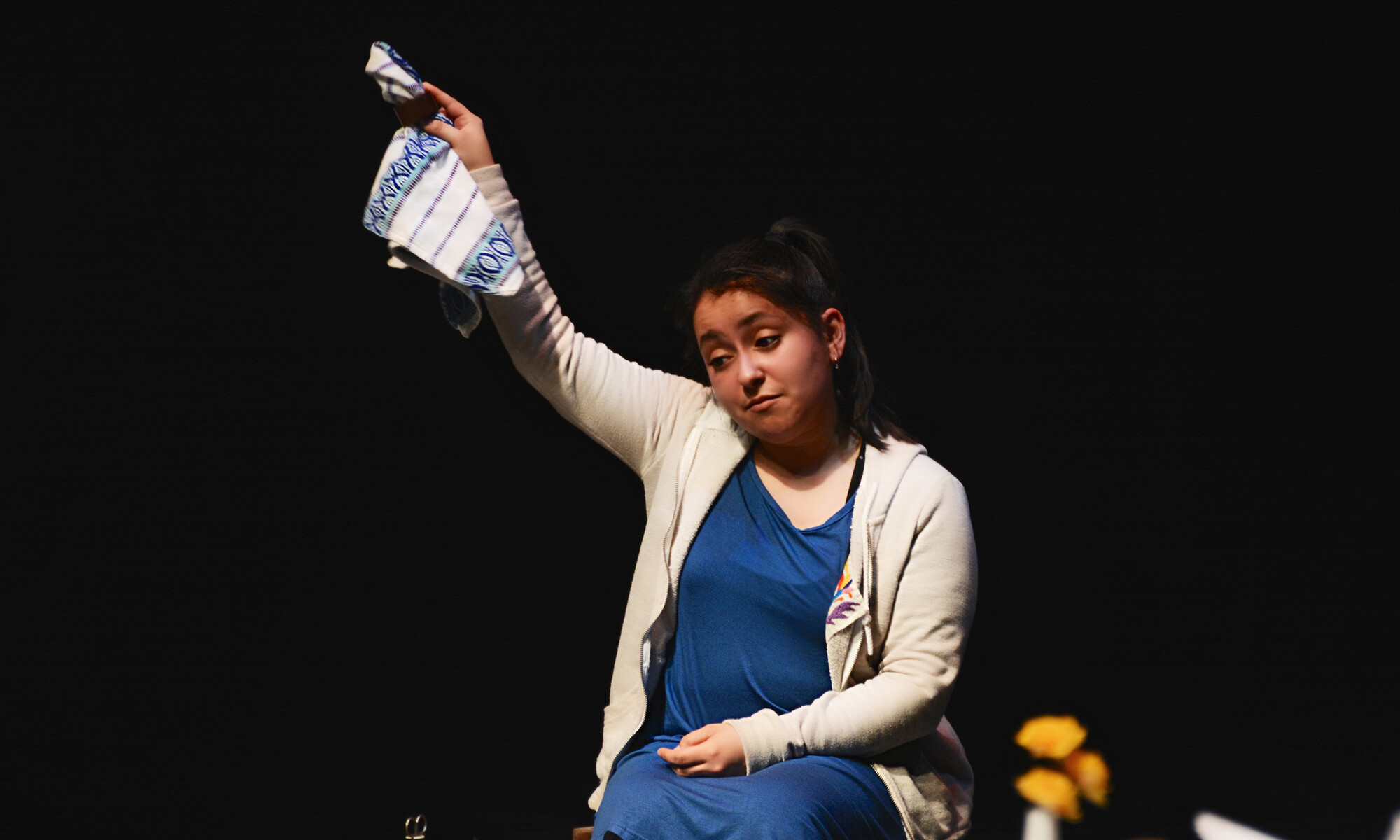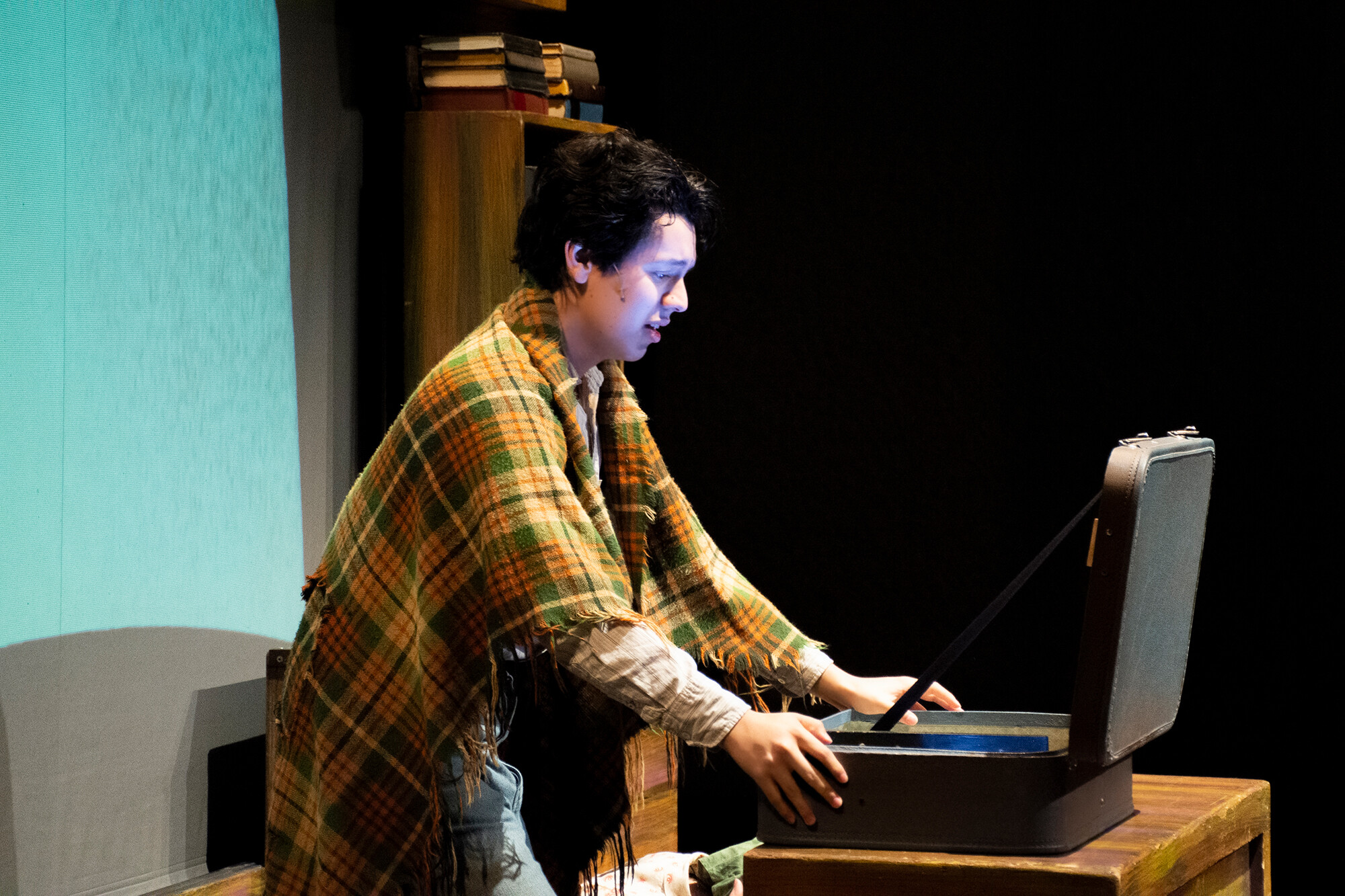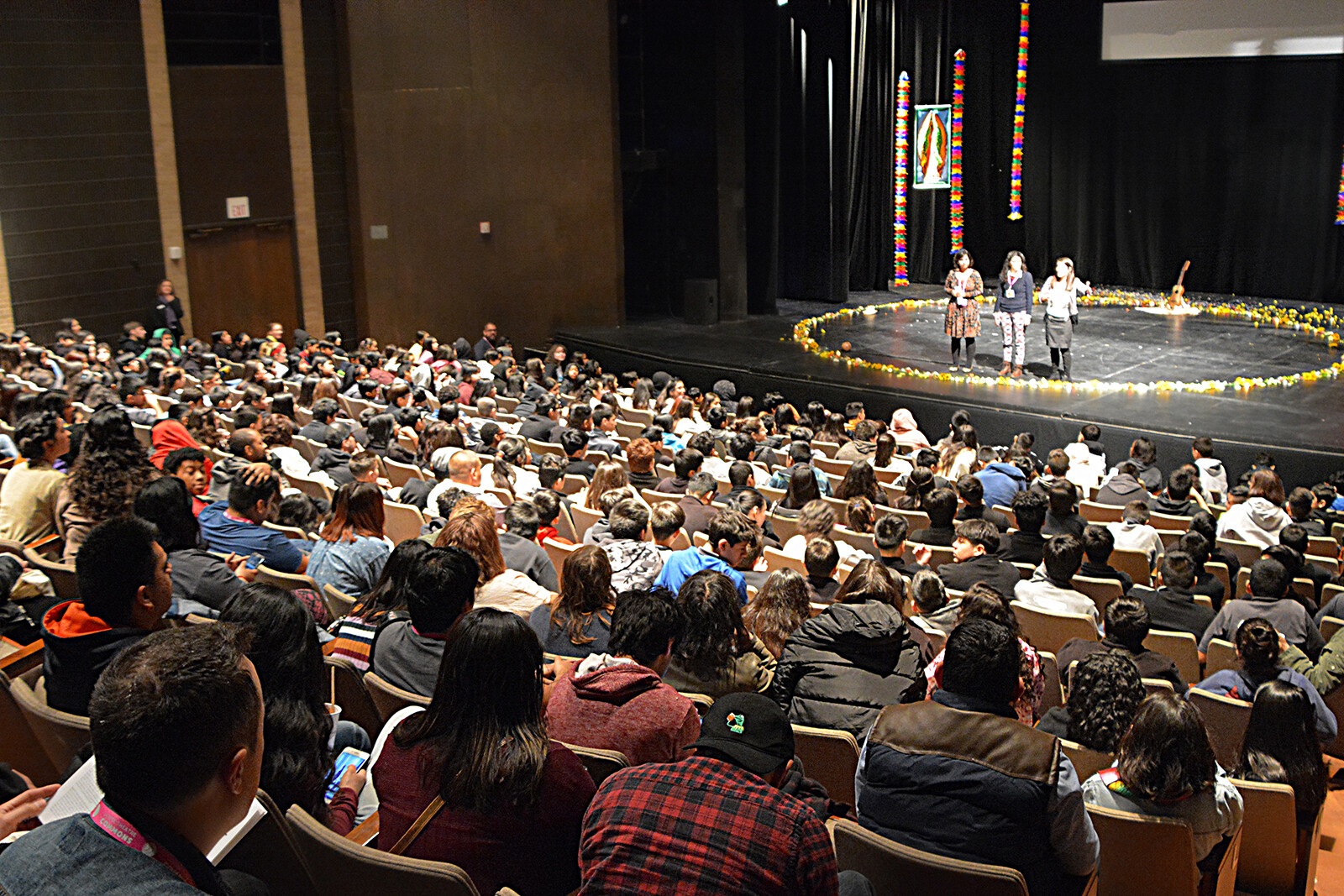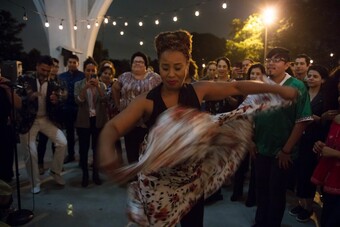Tomás and the Library Lady, directed by David Saar and presented by Childsplay, played to mostly adult conveners and community members. The piece tells the story of Chicanx writer and professor Tomás Rivera, the son of migrant workers and author of the classic book ...y no se lo tragó la tierra who develops a love for learning when he meets the “Library Lady.” The woman encourages Tomás to become a reader amidst a life of uncertainty and self-doubt. With bilingual verbal dialogue (English/Spanish) and digital projections, audiences experienced the protagonist’s development of literacy through his emerging self-esteem nurtured by books.
While all plays at the festival showcased the diversity, artistry, and various performance vocabularies of Latinx TYA, the plenaries focused on the labor and politics involved in creating and producing such work.
The bilingual (English/Spanish) Epic Tales from the Land of Melanin, directed by Ramos, connects back to Tomás and the Library Lady as a story centering protagonists who, like Tomás, are agents of their own destinies and are helped by their community. With verbal storytelling, sound, movement, DIY aesthetics, and audience participation, the show, based on histories of real-life women of color, follows three young female warrior-explorers on a journey to reclaim their individual and respective communities’ power from the “takers.” The audience aids them as they fight evil force fields and monsters they meet along their journey, where they learn that the power they seek has always resided in all of them and that community support is what’s needed to fight evil. Epic Tales from the Land of Melanin demonstrated that silliness and play keeps us in the harder issues longer.
While all plays at the festival showcased the diversity, artistry, and various performance vocabularies of Latinx TYA, the plenaries focused on the labor and politics involved in creating and producing such work. Adult conveners learned about the challenges of producing Latinx TYA and the inspirations and goals behind some of the major artistic creators and practitioners of this work.
“Exploring the Roots of TYA in Latin America and the United States” was moderated by Schroeder-Arce and included panelists Marco Novelo, professor at the School of Arts in Anahuac University Mexico; Miriam Gonzales, playwright of numerous Latinx TYA works; José Cruz Gonzalez, prolific Latinx TYA playwright and professor at California State University Los Angeles; José Casas, playwright and assistant professor of theatre, drama, and playwrighting at the University of Michigan; and Diana Guizado, actor and student in UT-Austin’s theatre and dance program. The panelists explored the roots of Latinx and Latin American TYA audiences, addressing the viability of the work, funding realities, the need to diversify TYA for youth of color, and the politics of white writers adapting Latinx stories for white theatre institutions.
In this session, we learned about issues of representation and visibility of Latinx playwrights, particularly the need for more Indigenous and Afro-Latinx TYA. On this point Schroeder-Arce asked, “Is there a certain kind of Latinx story that theatres want to produce?” Gonzales responded with: “It all goes back to who is accepted into the American Latinx family.”
It was clear that the majority of the panelists were driven to produce Latinx TYA because they did not see their communities represented on stages. As Casas powerfully proclaimed, “everyone’s stories deserve a space” and that we need “accomplices, not allies; people who look like us” writing and producing this work. Similarly, Gonzales remarked that TYA needs to represent the new narrative of America—where there is a blending of intersections, of inter-ethnic mixing—and that we need to look at the persistence of institutional racism to address why this work is not produced. Overall, the panelists remarked that stories of diverse representation of Latinx communities are out there, we just need to find them, publish them, and produce them—all the while ensuring that Latinx people are represented in positions of power in the producing process.
During the plenary “Producing Latinx TYA in our Theatres and Communities,” the topic of navigating Latinx TYA collaborations with historically white theatres came to the forefront. Moderated by Aguilar, the panelists included Rupert Reyes, founding artistic director of Teatro Vivo; Ramón Esquivel, Latinx TYA playwright and educator at Central Washington University; Crystal Mercado, founder and artistic director of Bocón Theatre Company; and Nat Miller, director of education at Zach Theatre. The conversation centered around the challenges, successes, and strategies in producing and advocating for Latinx TYA, as well as the logistics of working with area schools to bring young audiences to see this work. We also learned from each panelist about their unique regional producing circumstances and what types of stories they feel haven’t been told or need to be told. Mercado affirmed the need for more stories that “resist the ‘identity play’ and are not about proving our latinidad”—they can be about any themes, as long as they “have a family up there that looks like [us].”
When an audience member asked, “How do you not get swallowed up by a large theatre, especially when the ‘smaller’ theatre is run by people of color/Latinx people? How do you make sure it’s a partnership?,” dialogue among the panelists went deeper. Reyes said that you have to set non-negotiable collaboration guidelines and transparency up front. Mercado noted that you need to have the “hard and uncomfortable” meeting early on to ensure that the collaboration is equitable and that papers outlining the terms of collaboration are signed. Esquivel spoke to the larger context of institutional racism: that if you “lift your foot up off the gas” just a little bit, you should expect those inequalities to surface, and that, to avoid this, we need to ensure that the good, yet informal, relationships already built with ally institutions are institutionalized. Finally, Miller expressed that communication is key and shared that he and Reyes had many of those difficult conversations in their co-production of Cenicienta and subsequent collaborations.
The work, of course, is not yet done.
Much of the work of the convening happened off-stage and outside of the plenaries. In the opening night art sharing ¡Caleidoscopio!, conveners were able to experience the diversity and range of Latinx TYA being cultivated throughout the Américas. Curated by Kim Peter Kovac and UT students Maribel Leola and Juan Leyva, ¡Caleidoscopio! introduced conveners to new projects from both an older and newer generation of artistic creators, producers, and educators. Presenters shared Latinx TYA and Latinx work being produced in Chicago, Illinois; Seattle, Washington; Austin, Texas; San Antonio, Texas; Rio Grande Valley in Texas; Veracruz, Mexico; Tempe, Arizona; Denver, Colorado; Mexico City, Mexico; and Guatemala.
Conveners also had the choice to participate in several breakout sessions, including an interactive bilingual workshop “Face to Face with Rising Youth Theatre and Teatro Bravo,” led by Rising Youth Theatre and Teatro Bravo. Focused on teaching strategies for creating art with young people, the workshop leaders led participants on how to create art through intersectional frameworks. In an interactive laboratory for producers, presenters, and playwrights, “Devise and Conquer: Creative Collaborations in Commissions,” playwright Georgina Escobar led participants through a series of activating “commissioning prompts” (i.e. a climate change play, the reinvented classic, a new musical, a play for schools) to foster ways to develop new models of artistic collaboration between presenters, the community, and artists.











Comments
The article is just the start of the conversation—we want to know what you think about this subject, too! HowlRound is a space for knowledge-sharing, and we welcome spirited, thoughtful, and on-topic dialogue. Find our full comments policy here
Thank you for documenting this so thoughtfully, Marci!